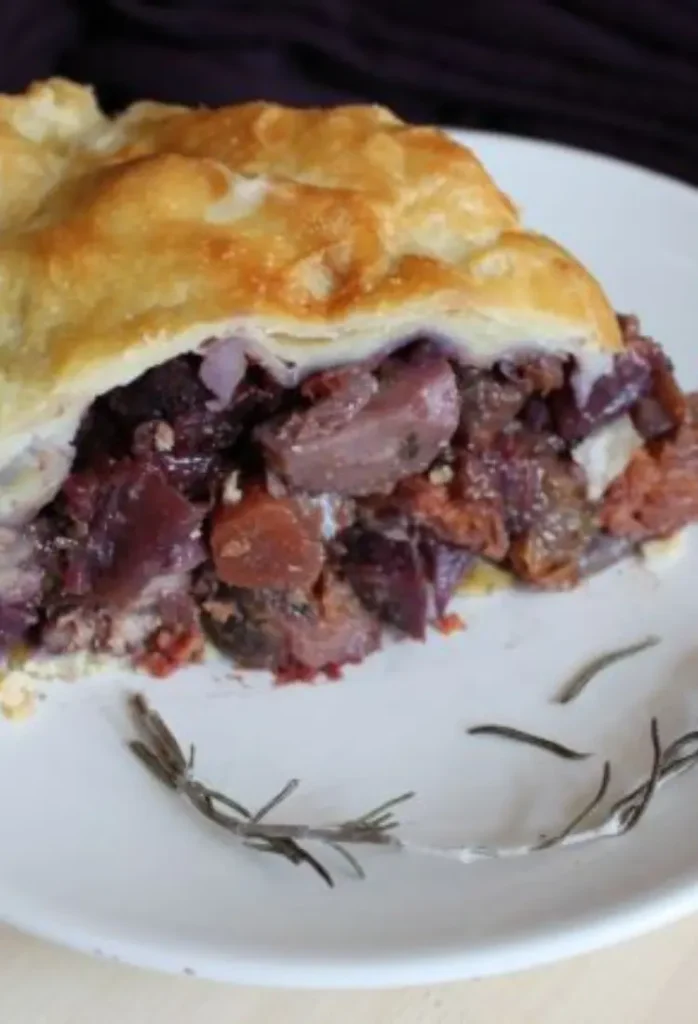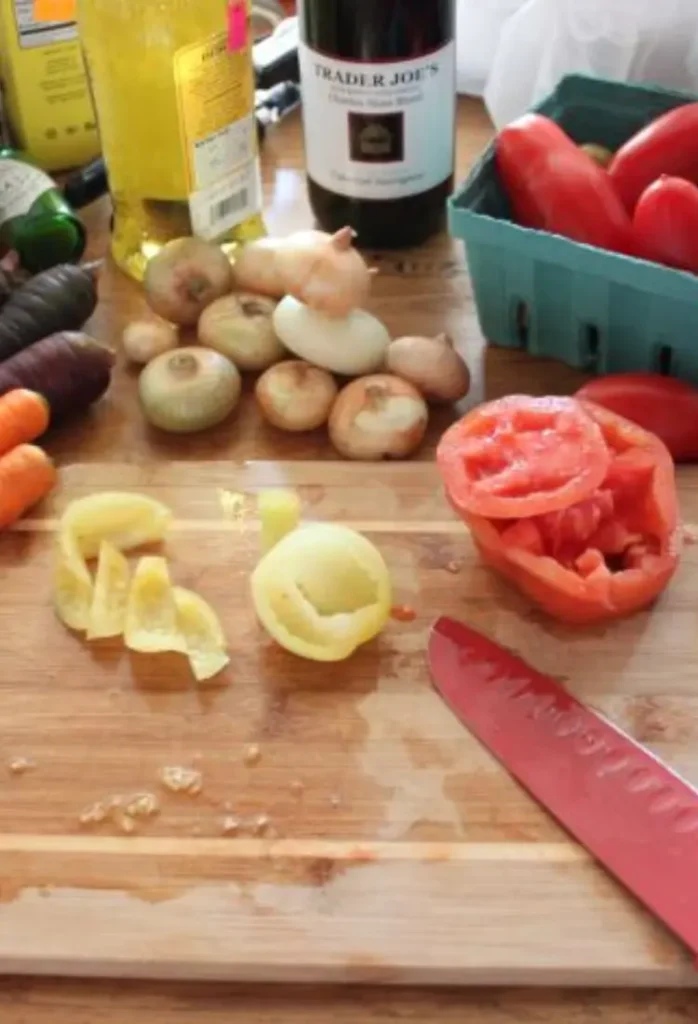A variation on hunter or shepherd’s pie; a savory lamb pie inspired by The House on the Dirt Between the Lake and the Woods, by Matt Bell.
When you crave “green space” in New York City, you head to a park where hundreds of other sweaty (often shirtless) people are fighting for a place to lay their picnic blankets. The operative word for most people is “green;” that desire to get out, get a little sun, and wiggle their toes in cigarette-butt-studded grass. Throw a Frisbee around. For me, it is the opposite. When I crave trees and running water, what I really need is space. I love being alone in the woods with nothing but leaves rotten logs and spider webs strung between blades of long grass. Give me a lake! God, the things I can do with a lake.
So when I read the title of Matt Bell’s The House on the Dirt Between the Lake and the Woods I thought, “That sounds like a house I’d want to live in.” I was grossly, painfully, disturbingly wrong.
Spoiler-Free Summary:
The nameless narrator and his wife move to the wilderness, a remote tract of dirt between a lake and a vast wood. The husband desperately wishes for a child, a desire his wife tries to fulfill in spite of her many miscarriages. Unfortunately, when their child appears he does not come in the form the husband expects.
Some Notes:
I don’t want to ruin all the strange twists and turns this story takes. Initially, it seems set up as a simple fairy tale, but it evolves very organically into something darker and richer. It’s deeply magical in the way that old myths and legends are. It does not prey upon or exploit the reader’s primal fear of things that go bump in the night, so much as it calmly and clearly validates the basic human fear of chaos and the wild. Are you afraid that there are things with teeth in the woods? Good, you should be. Are you afraid that there is something in the black depths of the lake about to brush against your toes? Good, you should be. Are you afraid of the person lying next to you at night? Good, you should be.
From there the story unravels even further, twisting these fears out of focus until they become magical; distorted, but still entirely rational. There is a kind of logic to the story, but it is the same logic you find in dreams.

Parsing This Pie:
With all the hunting and fishing and gristle in this book, how could it not be a meat pie? My experience on the savory side of pie is not quite as reliable as my sweet side, but I was confident that if I kept it simple and did a lot of research I could originate a fairly basic recipe.
Of course, I got ambitious and, without having ever tasted it before in my life, decided I wanted this to be a venison pie. Luckily, the butcher saved me from myself. Back in Ohio someone always knows someone who just happened to shoot a deer last weekend. But in Manhattan everything is money. Venison costs $21 per lb, the smallest pre-sealed cut they had. Three lbs! So in a perfect world, this would have been a venison pie, but it also wouldn’t have cost $63+ to make.
As I was standing in line I spotted some lamb stew meat in the case. The filling for meat pies is essentially a stew, which is a good way to think about it in terms of flavors, seasonings, and occasionally proportions. As gruesome and twisted as it sounds, the lamb kind of reminded me of the son in House on the Dirt, not only because he eats red meat (something unnatural to his parents), but also because (for the most part) he struck me as an innocent caught up in an otherwise gruesome tale.
I knew the meat had to be the centerpiece of this pie, from there it was just a matter of dressing it. Root vegetables seemed apropos, something to connect the pie to the dirt and the garden the couple keeps. And I stewed the whole thing in vegetable broth and red wine, which took all the autumn harvest colors I put in and turned them a bloody purple color. It was almost entirely unintentional but absolutely perfect.

Ingredients
Bottom Crust:
- 1 cup flour
- 2/3 cup butter
- 2-3 tbs water
Top Crust:
- 1 cup flour
- 1 cup butter
- 2/3 cup water
- splash apple cider vinegar
Filling:
- Olive oil
- 2 tbsp rosemary, chopped
- 1 cup pearl/cipollini onions, cut into fourths
- 1 cup carrots, cut into rounds
- 1 cup purple carrots, cut into rounds
- 1 ½ cups potatoes (I used Austrian crescent fingerling), cubed
- ½ cup sweet potato
- 1 lb lamb stewing meat, cubed
- 2 cups heirloom tomatoes, chunked
- 1 ½ cup veggie broth
- 1 ½ cups red wine (I used Trader Joe’s $2.99 chardonnay)
- Salt and pepper
How to Make Bear Harvest Pie?
Step 1:
I use two different crusts for meat pies. The bottom crust has more flour to butter than the top crust. The idea is that it can retain liquid without melting or becoming soft. The top crust has equal portions of butter to flour, which melts a bit in the oven (and has smoked up my apartment more than once), but which comes out much flakier, crispier, and almost bread-like.
Step 2:
The bottom crust is the same durable, workable crust I use for most of my pies, and the instructions remain the same: cube the butter, combine all the ingredients, cut together, and knead until they come into a cohesive but shaggy ball. For the top crust, the instructions are essentially the same, however, the texture of this crust is a bit wetter. when it comes together it can be rather sticky. I usually flour the outside of the ball until it is soft but dry. The other thing about the top crust is that you really want the butter to be evenly incorporated. You should be able to see that butter striation, little veins of unincorporated yellow, but if there are big chunks they will melt, drip, and smoke up your house. (Also very apt for the story, I’ve just realized.)
Step 3:
Set both crusts in the refrigerator to keep cool.
Step 4:
A note on cutting ingredients: you want all of the cubes, rounds, and chunks to be bite-sized. Very important. No one likes wrestling with a particularly large carrot, it distracts.
Step 5:
For the filling, heat about 3 tbs of olive oil and 1 tbs of rosemary in a large saucepan or a high-sided saute pan (I prefer the latter) over medium heat. Brown the onions for about 5 minutes. Then add a bit more oil and add the carrots, potatoes, and sweet potatoes. Allow them to cook for about 10 minutes. They should soften up a bit and become slightly translucent.
Step 6:
Add the cubed meat. I had enough space in my massive saute pan that I could push all the veggies to one side and use the empty half to seal the lamb meat over brown. If your pan is too crowded, just heat a bit of extra oil and rosemary in a separate frying pan and do it there. You want to make sure that each cube is browned on all sides, and cooked superficially before you stew it.
Step 7:
Once the meat has been fully incorporated into the root vegetables, add the tomatoes, broth, and red wine. Add the second tablespoon of rosemary and salt and pepper as you like it. Cover and bring it down to a low heat, allowing it to simmer and stew. The vegetables should be soft to the bite and the lamb should be cooked through, I would say about 30 minutes.
Step 8:
Preheat the oven to 375 degrees Fahrenheit.
Step 9:
Meanwhile, roll out your bottom crust and line your pie plate. When the filling is done stewing, allow it to cool a bit and then ladle the filling in with a slotted spoon. Don’t worry, plenty of meaty juices are going to make it into the pie, but you want as little extra liquid as possible.
Step 10:
Roll out your top crust, it will be a little bit thicker and fluffier. Lay it over your filling, roll the edges, and egg wash. Pop it in the oven for about 30 minutes or until golden brown. (Also, maybe put a cookie sheet under the pie in case the butter top crust melts. It will save you the back-breaking work of scrubbing the inside of your oven.)
Step 11:
Allow this pie to cool and serve immediately for best results. Enjoy on a cool, dark, moonlit autumn night, preferably with a pint of good beer, perhaps while eyeing your loved ones suspiciously.

